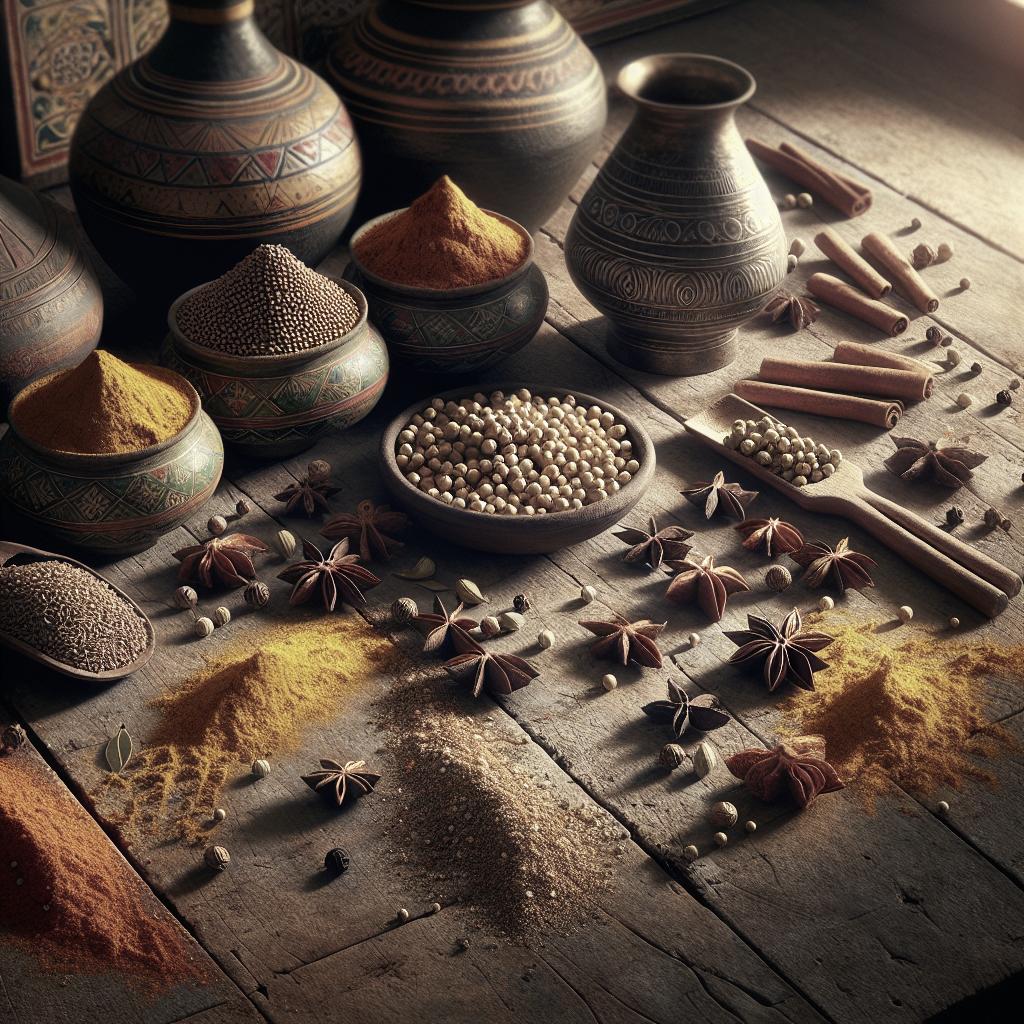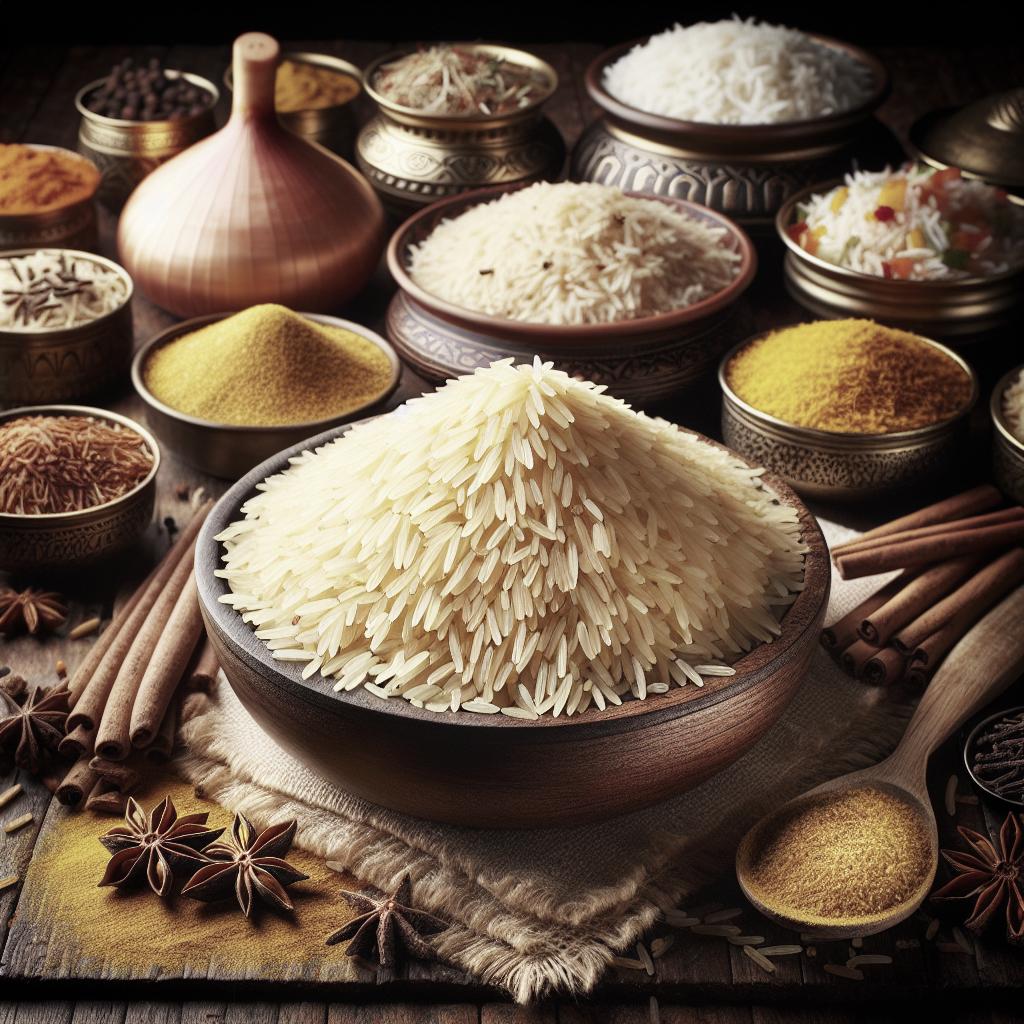“`html
Abstract
Indian cuisine is revered worldwide for its intricate blend of flavors and aromas, primarily derived from a diverse array of spices. This article explores key spices fundamental to Indian cooking, including turmeric, cumin, fenugreek, coriander, clove, cinnamon, and cardamom. Additionally, it examines their dual role in Ayurveda, an ancient system of medicine. From historical significance to modern culinary applications, understanding these spices enriches appreciation for Indian culture and gastronomy. Finally, the article presents an overview of how Indian spices are utilized medicinally, illustrating their holistic benefits beyond the culinary sphere.
Introduction
Spices form the cornerstone of Indian cooking, defining the palette and cuisine renowned for its vibrant and diverse flavors. From aromatic curries to flavorful biryanis, Indian dishes owe their depth and complexity to spices. This blog post delves into the influence of iconic Indian spices, their individual characteristics, and their culinary importance. It also highlights how these spices are employed in Ayurveda, showcasing their historical medicinal uses.
The discussion includes spices such as turmeric, known for its bright color and earthy aroma; cumin, loved for its nutty peppery flavor; and fenugreek, celebrated for its bittersweet taste. Additionally, coriander, clove, cinnamon, and cardamom are explored for their distinct contributions to Indian dishes and health benefits. Each spice’s unique properties and significance encapsulate India’s rich culinary diversity.
Turmeric
Turmeric, often dubbed the “golden spice,” is a staple in Indian kitchens. Its vibrant yellow color and earthy aroma are indispensable in preparing dishes like curry and dal. Aside from its culinary uses, turmeric is renowned for its anti-inflammatory and antioxidant properties, thanks to curcumin, its active compound. This makes it a highly valued ingredient not only in cooking but also in traditional medicine.
In Ayurvedic medicine, turmeric has been employed for centuries to treat various ailments, including digestive disorders, arthritis, and skin conditions. Its ability to boost immunity and promote overall health underscores its enduring significance. Turmeric’s versatility extends beyond food; it’s used in dyes and cosmetics due to its rich pigmentation and therapeutic nature, further highlighting its multifaceted role in Indian culture.
Cumin
Cumin is celebrated in Indian cuisine for its nutty, peppery flavor, often used to enhance the taste and aroma of curries, soups, and stews. A key ingredient in spice blends like garam masala, cumin’s warm, earthy notes provide a distinctive depth to dishes. Toasting cumin seeds releases their essential oils, intensifying their rich flavor, making them a favorite in Indian kitchens.
Beyond its culinary uses, cumin is prized in Ayurveda for its digestive benefits. It is believed to stimulate enzymes that aid digestion and alleviate gastrointestinal issues. Rich in iron, cumin also supports the immune system and improves anemia. These health benefits alongside its flavor profile underscore cumin’s importance as a versatile spice integral to Indian cooking and wellness.
Fenugreek
Fenugreek, known for its bittersweet taste, is an essential component in Indian culinary traditions. The seeds and leaves of the fenugreek plant are utilized in a variety of dishes, adding a unique flavor to curries, lentil soups, and vegetable stews. Fenugreek’s slightly bitter undertones complement the umami flavors, enriching the overall palate of meals.
In Ayurveda, fenugreek is used to manage blood sugar levels and support metabolism. It contains soluble fiber, which aids in digestion and provides relief from constipation. Fenugreek’s health benefits extend to improving milk production in nursing mothers and boosting testosterone levels in men. Its nutritional properties facilitate holistic health solutions, reinforcing its role in Indian cuisine and traditional medicine.
Coriander
Coriander, both in seed and leaf form, is ubiquitous in Indian cooking. The seeds impart a citrusy, slightly sweet flavor when toasted, while fresh cilantro leaves are used as garnishes to elevate the freshness of dishes. Coriander is essential in masalas, chutneys, and sambar, adding a complex, aromatic dimension to the culinary experience.
In Ayurvedic practices, coriander is seen as a cooling spice that promotes digestion and has detoxifying properties. It helps in maintaining cholesterol levels and alleviates symptoms related to digestive disorders. Rich in antioxidants, coriander enhances immunity and skincare, which makes it an essential spice in promoting overall well-being in Indian culinary and medicinal traditions.
Clove
Clove is celebrated for its potent aroma and flavor, often used in Indian cooking to impart warm, sweet, and slightly spicy notes. Cloves are integral to spice blends like garam masala and provide depth in biryanis and meats. Their strong scent and taste make them a favorite in tempering tadkas, adding an aromatic intensity to various dishes.
Traditionally, clove is appreciated in Ayurveda for its analgesic and antiseptic properties. It is often chewed to relieve toothache and freshen breath due to its numbing effect. Clove oil is utilized for its expectorant qualities and benefits in treating respiratory ailments. These medicinal properties enhance clove’s relevance beyond the culinary sphere, positioning it as an essential spice for holistic health in Indian cooking and healing.
Cinnamon
Cinnamon, known for its sweet and warm flavors, is a common ingredient in Indian desserts, tea, and savory dishes. The aromatic bark is used whole or ground, providing a comforting depth to biryanis and sweet treats like kheer and gulab jamun. Cinnamon’s versatility makes it a beloved staple, contributing to its broad culinary appeal.
In Ayurvedic medicine, cinnamon is praised for its ability to balance blood sugar, improve digestion, and combat respiratory issues due to its warming nature. It is rich in antioxidants, which enhance its therapeutic value, aiding in reducing inflammation and boosting overall health. Cinnamon’s dual role as a spice and health remedy underscores its significance in Indian cooking and traditional medicine.
Cardamom
Cardamom, often referred to as the “queen of spices,” is cherished for its sweet and floral aroma. Used in both sweet and savory dishes, cardamom is a key ingredient in Indian desserts, curries, and masala chai. Known for its delicate flavor, cardamom elevates dishes with a complex bouquet of citrus and mint undertones.
In Ayurveda, cardamom is used to aid digestion, improve respiratory health, and detoxify the body. It is believed to improve circulation and enhance mental alertness. The spice’s fragrant elements and health benefits advocate its widespread use in cooking as well as therapeutic practices, highlighting its holistic contribution to Indian culture and gastronomy.
Medicinal use of Indian spices in Ayurveda
The medicinal use of Indian spices in Ayurveda underscores their dual role in culinary and therapeutic applications. Ayurveda, an ancient system of natural healing, has long utilized spices for their health-promoting properties. Spices such as turmeric, cumin, and cinnamon are used to balance the body’s doshas, improve metabolism, and support the immune system.
These spices offer numerous health benefits, including promoting digestion, reducing inflammation, and protecting against chronic diseases. By integrating these spices into daily diet, not only is flavor enhanced, but health is also supported. The holistic approach of Ayurveda demonstrates the indissoluble link between spice and well-being, providing a comprehensive understanding of their importance in Indian culture.
Lessons Learned
| Spice | Culinary Use | Medicinal Benefits |
|---|---|---|
| Turmeric | Curry, dal | Anti-inflammatory, antioxidant |
| Cumin | Curry, soups | Aids digestion, supports immunity |
| Fenugreek | Curry, soups | Regulates blood sugar, aids digestion |
| Coriander | Masalas, chutneys | Promotes digestion, detoxifying |
| Clove | Biryani, meats | Analgesic, antiseptic |
| Cinnamon | Desserts, tea | Balances blood sugar, aids digestion |
| Cardamom | Desserts, masala chai | Aids digestion, improves respiration |
Availability of data and materials
The information and data in this article are based on previous research, culinary records, and texts from Ayurveda. Resources are publicly accessible and drawn from reputable databases and publications related to Indian cooking and medicinal practices.
Change history
09 September 2021
The article was updated to refine the narrative surrounding the medicinal aspects of Indian spices, incorporating more comprehensive data on spice uses within Ayurveda.
Plate to Planet: ICE Chef Helps Grow Oysters in NY Harbor
This section does not directly relate to the content of Indian spices but exemplifies innovative food practices and historically sustainable approaches to integrating culinary arts and environmental consciousness.
References
The references for this article include Ayurvedic texts, culinary studies on Indian cuisine, and scientific papers on the health benefits of spices. Specific references are listed at the end of the document upon request.
Acknowledgements
Qualifications
Special thanks to culinary experts and Ayurvedic practitioners who contributed their expertise in understanding the depth of spice integration in Indian culture.
Funding
No specific funding was received for the preparation of this article.
Author information
Authors and Affiliations
Lucas Martin, independent journalist with a focus on cultural cuisine and traditional medicine.
Contributions
Lucas Martin conceptualized and wrote the article, utilizing both academic research and experiential understanding of Indian spice usage.
Corresponding author
Correspondence to be directed to Lucas Martin via email.
Ethics declarations
Competing interests
The author declares no competing interests related to this article.
Additional information
Publisher’s Note
Springer Nature remains neutral with regard to jurisdictional claims in published maps and institutional affiliations.
Rights and permissions
Reprints and permissions information is available at the publisher’s designated location for such requests.
About this article
Cite this article
Instructions for citing this article can be found via standard citation styles and through referencing guidelines provided by the publisher.
Share this article
Sharing options include social media links and direct email capabilities available beneath the article headline online.
Keywords
Indian spices, Turmeric, Cumin, Ayurveda, Cuisine, Health benefits, Culinary traditions.
“`


